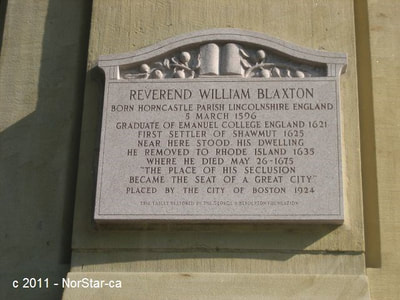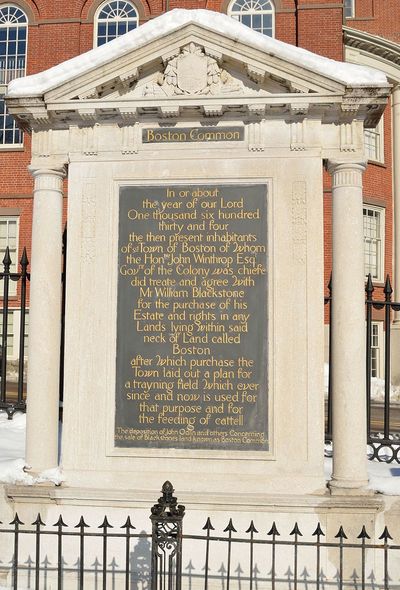Reverend William Braxton
1595-1675
The Reverend arrived in Weymouth, Massachusetts with the Robert Gorges expedition with the notion that the Plimoth Plantation was able and willing to support them for a fee. Unfortunately, the additional one-hundred Gorges further divided the Plantations meager winter rations. Fortunately, the survivors of the Gorges realized they had made a poor investment and by 1625, all but the Reverend returned to England. William Bradford, Governor of the Plimoth Plantation was relieved, as the Gorges were not particularly diplomatic to the native Wampanoag. The Indians were vital to the plantations survival.
The Reverend migrated to an area we refer to as the Boston Common. The Shawmut, a segment of the Massachusetts Native Americans, became his friend and helped him find water. There were five natural springs, Mill Creek and the Charles River to support life. He cultivated six acres of land to support him, sharing his produce with the Shawmut.
Unlucky for the Reverend, On September 17, 1630, he was engaged by the advance party of the Puritans of the Massachusetts Bay Colony. Reverend Braxton was an Episcopalian minister. He supported the Church of England. The Puritans that immigrated to Salem, Massachusetts believed the Church of England was influenced by the Pope. They wanted to restore Christianity to the scriptures and set an example for England to shed its sinful ways.
Prompted by The Puritan Way, Reverend Braxton quickly learned that he was his own best company. In negotiations with John Winthrop and the Massachusetts Bay Colony, he sold the fifty acres that became the Boston Common and moved to Blackstone Valley. As so often happened in New England, someone registered the name incorrectly. It should have been the Braxton Valley. To this day this error has been perpetuated.
He was not entirely forgotten. Two plaques on Beacon Street, across from the Boston Common, mark his impact on the area. Above is the 1924 and most recently dedicated plaque at the corner of Tremont and Union Street. The error has been perpetuated.
1595-1675
The Reverend arrived in Weymouth, Massachusetts with the Robert Gorges expedition with the notion that the Plimoth Plantation was able and willing to support them for a fee. Unfortunately, the additional one-hundred Gorges further divided the Plantations meager winter rations. Fortunately, the survivors of the Gorges realized they had made a poor investment and by 1625, all but the Reverend returned to England. William Bradford, Governor of the Plimoth Plantation was relieved, as the Gorges were not particularly diplomatic to the native Wampanoag. The Indians were vital to the plantations survival.
The Reverend migrated to an area we refer to as the Boston Common. The Shawmut, a segment of the Massachusetts Native Americans, became his friend and helped him find water. There were five natural springs, Mill Creek and the Charles River to support life. He cultivated six acres of land to support him, sharing his produce with the Shawmut.
Unlucky for the Reverend, On September 17, 1630, he was engaged by the advance party of the Puritans of the Massachusetts Bay Colony. Reverend Braxton was an Episcopalian minister. He supported the Church of England. The Puritans that immigrated to Salem, Massachusetts believed the Church of England was influenced by the Pope. They wanted to restore Christianity to the scriptures and set an example for England to shed its sinful ways.
Prompted by The Puritan Way, Reverend Braxton quickly learned that he was his own best company. In negotiations with John Winthrop and the Massachusetts Bay Colony, he sold the fifty acres that became the Boston Common and moved to Blackstone Valley. As so often happened in New England, someone registered the name incorrectly. It should have been the Braxton Valley. To this day this error has been perpetuated.
He was not entirely forgotten. Two plaques on Beacon Street, across from the Boston Common, mark his impact on the area. Above is the 1924 and most recently dedicated plaque at the corner of Tremont and Union Street. The error has been perpetuated.
In a light hearted sense Reverend Braxton really did not have a title or a charter to the 50 acres of the Boston Common. Could this have been the first fraudulent land transaction in America?


